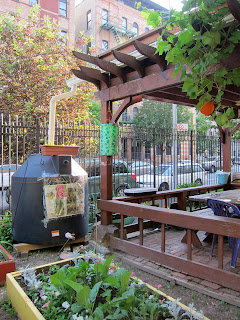Aspen Farms, Philadelphia, 1999
My community gardening experience is directly tied to the ACGA conferences in many ways. I attended my first conference in New York City in 1985 and found a job announcement advertising the position at Council on the Environment which became my job a few months later. I have attended 16 other conferences which together have been a bi-national tour of cities in the US and Canada. I've had the pleasure of visiting Seattle, Philadelphia, Milwaukee, Cleveland, Denver, Louisville, Chicago, Montreal, Indianapolis, Dayton, Atlanta, Toronto, Minneapolis/St.Paul and Los Angeles. Community Gardens in each city reflected the flavor of the city and region as well as ethnic and immigrant cultures inhabiting that city.
Mr. McGregors Garden, Dayton, 1997
For 6 years in the early to mid 1990's I served on the ACGA Board of Directors, most of that time as the Chair of the Publications Committee responsible for publishing the Community Greening Review. Of course those were the days before ACGA had a website and the board members were pioneering a new way to communicate between semi-annual meetings called e-mail. The Community Greening Reviews did provide in depth articles about community gardening at a time when very few researchers were studying and writing about the subject. These articles served as seminal works that have informed and inspired the current generation of researchers.
Wattles Garden, Los Angeles, 2006
At several conferences I presented workshops on Council on the Environment programs, rainwater harvesting and community garden mapping. This year's conference has workshops on youth gardening, sustainability, advocacy and community development. The workshops are informative and helpful but the most interesting part of ACGA conferences are the garden tours. The pictures included in this blog post were taken on some of those garden tours. The tours at this conference are by bus, bike and foot, are all themed, include a workshop or service component related to the theme and lunch in one of the gardens. To truly appreciate New York City community gardens it is best to visit them. I will be leading a bus tour of community gardens in the south Bronx that have a connection to schools in the neighborhood.
Community Garden, Minneapolis, 2005
For anyone who has an interest in community gardens, school gardens, urban agriculture, sustainability or community building, the ACGA conference has all of that and more. Who knows it could lead to a job, an avocation as a presenter, an election to the ACGA Board of Directors or even to a Blog!
Miracle Garden, New York City, 2010









